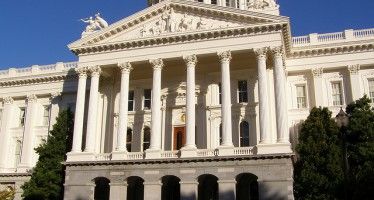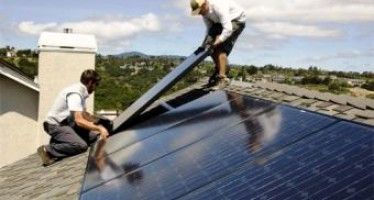Alt Energy Makes State Budget Redder
DEC. 20, 2010
By LAER PEARCE
When the 2010 Los Angeles Auto Show opened last month, Gov. Arnold Schwarzenegger was there, which is not surprising since the manly man is quite the car lover. Remember his H1 Hummer? Or his Ferrari 360 Spider? But this time, he was standing in front of a display of 14 alternative fuel vehicles, including plug-in hybrids and full-on electric cars.
Mary Nichols, California’s Green Queen and Air Resources Board director, introduced the governor as the leader of California’s rush to embrace cars that are fundamentally antithetical to his old Hummer. Schwarzenegger thanked Nichols for her introduction, noting in passing that “we grabbed her and brought her out here” because of her work in support of cap and trade. Then, calling the non-gasoline or low-gasoline cars arrayed behind him fantastic and gorgeous, he said, “For us it doesn’t make any difference if it’s a hydrogen car that is the solution, if it’s an electric car, a plug-in hybrid or whatever it is. … The bottom line is we want to eventually get off fossil fuels.”
If that’s the bottom line, it’s a good thing for Schwarzenegger he’ll be out of Sacramento soon, because balancing the state’s ever-redder budget will get that much harder every time a Californian moves from a gas-powered car to a plug-in. That’s because when Californians pump a gallon of gas into the tank, they’re paying 65 cents in state, federal and local sales taxes – the highest total gas tax in the nation – creating a green river flowing into Sacramento that’s part of a total of $100 billion in annual gasoline taxes at all levels of government across the nation. Yet the state is subsidizing the very cars that will cut this revenue stream, with financial incentives like those that will allow some lucky Californians to buy a $32,780 all-electric Nissan Leaf for as little as $12,280, and non-financial ones, like the free pass to drive a hybrid solo in carpool lanes – even though hybrids are most efficient in stop-and-go traffic.
The gasoline tax is supposed to be spent on transportation improvements, but the Legislature’s adeptness at finding ways around that barrier hit a roadblock with the passage of Prop. 26, which imposes a two-thirds vote requirement before fees can be raised. Since it’s retroactive to Jan. 1, 2010, it negates the “gas tax swap” the Legislature cooked up in March. The swap of fuel sales taxes and fuel excise taxes had transferred about $1 billion out of the transportation fund to the general fund, where we can bet it would have been spent on just about anything but road improvements. Now it’s all back in the transportation fund, digging the General Fund budget hole a billion dollars deeper.
Still, California insists on shooting itself in the revenue foot by incentivizing reductions in fuel use. Pressed on the disastrous fiscal consequences of the state’s position, CARB director Nichols refused to address the problem, saying nothing more than, “It is an issue we will have to deal with.” The normal solutions – fees per mile or per kilowatt hour for electric vehicles, for example – are now off the table for all intents and purposes since they will require a two-thirds majority to pass, yet the state still insists on underwriting uncompetitive battery buggies.
Another big question about electric cars also remains unanswered: Will environmentalist supporters of the technology also support the new power plants needed to charge their batteries? Not hardly. Instead, they will push for California’s electric grid to be filled with more alternative energy, which can be defined as energy that does not make sense economically. Alternative fuel is more expensive, so electric cars will be even less competitive against gasoline-powered cars, and therefore will need even greater government incentives if they’re to become popular. And environmentalists will fight wind farms and desert solar plants every step of the way, all the while demanding we stop relying on gasoline.
But that’s just the tip of the electricity supply problem. In Shepherd Flats, Oreg., the wind turbines of the world’s largest wind farm turn for California and nowhere else, as 100 percent of the field’s output goes south. In all, 55 percent to 65 percent of the Northwest’s wind energy is generated for California, so our utilities can meet state mandates demanding more of the state’s energy come from alternative sources.
So big is our energy-sucking that the Bonneville Power Administration – Northwestern energy’s big Kahuna – frequently has to dump water from its dams instead of using it to generate electricity because the region’s grid is already full of wind-generated electricity. Last June, Bonneville actually was giving electricity away because so much wind energy was in the system. That seems swell, but it’s bad for migrating salmon and it wrecks Bonneville’s financials.
Why is the energy hanging around in the Northwest’s grid instead of being on its way to California? Because California utilities don’t actually use the wind energy; they just use the “wind credits” they buy in Washington and Oregon to count towards their mandated green energy use. Why don’t the California utilities just buy their green credits from Bonneville – or pick up the surplus electricity for free – since hydroelectric power is about as green as it gets? They can’t, because the anti-dam environmentalists in the California Legislature refuse to count hydroelectric power as green power, even though it burns no carbon.
So we’ll be buying wind-generated energy we’re not using, and will be not using it to power electric cars we’ve been incentivized to buy even though they dig our budget hole deeper. All of which proves there is a highway to Hell, and it runs straight through Sacramento.
Laer Pearce, a veteran of three decades of California public affairs, is currently working on a book that shows how everything wrong with America comes from California.
Related Articles
Campaign 2016: Bipartisan group files pension reform initiative
The battle over California’s out-of-control public employee pensions could soon move from the courtroom to the ballot box. A bipartisan group of pension
Maviglio tweets against Duffy global-warming article
April 10, 2013 By John Seiler Steve Maviglio, the California Democratic activist, tweeted about Warren Duffy’s article on our site,
Study: Vast CA solar power possible using existing infrastructure
A new study for Nature Climate Central journal says California could have abundant solar power to meet all of its




